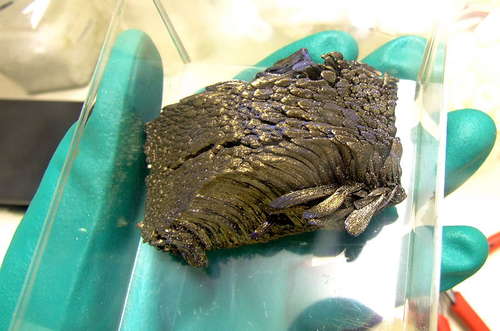by Larry
July, 2010Rare Earth ConsiderationsArguably, the green revolution will not succeed over the next quarter-century or so without better access to certain "heavy" rare earth elements (HREE). For example, Europium is needed for putting the color in television and other widely used screens as well as for phosphors, lasers, and mercury-vapor lamps. Dysprosium is found in green technology magnets, in lasers, and in hybrid car motors. Promethium, though highly unstable, is needed for nuclear batteries. Ytterbium is found in certain lasers, in reducing agents, and in high-temperature superconductors. Rare earth elements are also key components in wind turbines and iPhones.
Just as OPEC, the Organization of Petroleum Exporting Countries, mostly in the Middle East, for awhile had a strangle hold on the world's oil supply, so now China has a virtual monopoly on the production of HREE. This has come about due to a variety of factors. The industrial processes involved are dangerous. Often there is hazardous waste. Workers who are not well protected can suffer severely or even be killed by unsafe methods. Similarly, waste from HREE production that has not been properly disposed of may create toxic environmental disasters, with nearby communities at great risk. China has been farsighted and recognized the importance of this type production. It is fortunate to possess more of the world's supplies of ores that include HREE than other lands. The country also is often not particularly careful about the health and welfare of its workers or of people living near HREE plants and their waste. Also, China's industrial development is partly state controlled. There are both domestic consumption concerns and a drive for greater world hegemony as incentives for the Chinese to produce most of the globe's demand for HREE. To date, they have been rather successful and produce over 97% of the world's HREE supplies. Western countries will thus have little choice but to cater to China if they want ongoing cutting-edge technologies to be maintained. Yet China, ostensibly out of recent concern for a future shortage affecting their own population's access and also for the safety of its workers and communities, has lately reduced its HREE operations to levels that will not assure significant supplies being available to the West. Even if China should have persisted in producing HREE at a flat-out, damn the torpedoes, full speed ahead rate, their own efforts would likely not have been adequate to keep up with demand in the next several decades as an essential transition from carbon-based technologies to green alternatives gets more fully underway. Recognition of the looming bottleneck and its implications has some politicians and companies in the West scrambling for new means to sustainable HREE mining and manufacture. Eventually rare earth sources are likely to be maximized in the U.S. as well as in Australia, Brazil, Canada, and South Africa. Such efforts will be costly and time-consuming, though. Almost certainly, there will be little choice but to accept and deal with China's HREE monopoly in both the short- and medium-term. Sources: Are Rare Earth Elements Actually Rare? Charles Homans in Foreign Policy magazine; July 13, 2010. Element Photo Gallery. Anne Marie Helmenstine, Ph.D. in About.com; 2010. Rare Earth Elements. Wikipedia; last updated 13 July, 2010. |
